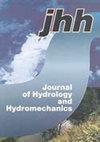Using feature engineering and machine learning in FAO reference evapotranspiration estimation
IF 2.4
4区 环境科学与生态学
Q3 WATER RESOURCES
引用次数: 0
Abstract
Abstract The authors of this study investigated the use of machine learning (ML) and feature engineering (FE) techniques to accurately determine FAO reference evapotranspiration ( ETo ) with a minimal number of climate variables being measured. The recommended techniques for areas with insufficient measurements are based solely on daily temperature readings. Various ML methods were tested to evaluate how sophisticated an ML algorithm is for this task necessary. The main emphasis was on feature engineering, which involves converting raw variables into inputs better suited for ML algorithms, resulting in improved results. FE methods for estimating evapotranspiration include approximations of clear-sky solar radiation based on altitude and Julian day, approximate relative humidity and wind velocity, a categorical month variable, and variables interactions. The authors confirmed that the ability of ML in such tasks is not solely dependent on choosing the suitable algorithm but also on this frequently ignored step. The results of computational experiments are presented, accompanied by a comparison of the proposed method against standard ETo empiric equations. Machine learning methods, mainly due to the transformation of raw variables using FE, provided better results than traditional empirical methods and sophisticated ML algorithms without FE. In addition, the authors tested the applicability of the developed models in the broader area to evaluate the possibility of their generalizability. The potential of this approach to deliver improved predictions, reduced input requirements, and increased efficiency holds interesting promise for optimizing water management strategies, irrigation planning, and decision-making within the agricultural sector.在粮农组织参考蒸散发估计中使用特征工程和机器学习
本研究的作者研究了使用机器学习(ML)和特征工程(FE)技术,在测量的气候变量数量最少的情况下准确确定FAO参考蒸散量(ETo)。对于测量不足的地区,推荐的技术仅基于每日温度读数。测试了各种ML方法,以评估ML算法对于该任务的复杂程度。主要的重点是特征工程,包括将原始变量转换为更适合ML算法的输入,从而提高结果。估算蒸散发的有限元方法包括基于高度和儒略日的晴空太阳辐射近似值、近似相对湿度和风速、分类月份变量和变量相互作用。作者证实,机器学习在这些任务中的能力不仅取决于选择合适的算法,还取决于这个经常被忽略的步骤。给出了计算实验结果,并将所提出的方法与标准ETo经验方程进行了比较。机器学习方法,主要是由于使用FE对原始变量进行转换,提供了比传统经验方法和不使用FE的复杂ML算法更好的结果。此外,作者还测试了所开发模型在更广泛领域的适用性,以评估其推广的可能性。这种方法在提供更好的预测、减少投入需求和提高效率方面的潜力,为优化农业部门的水管理战略、灌溉规划和决策带来了有趣的前景。
本文章由计算机程序翻译,如有差异,请以英文原文为准。
求助全文
约1分钟内获得全文
求助全文
来源期刊
CiteScore
4.20
自引率
5.30%
发文量
30
审稿时长
>12 weeks
期刊介绍:
JOURNAL OF HYDROLOGY AND HYDROMECHANICS is an international open access journal for the basic disciplines of water sciences. The scope of hydrology is limited to biohydrology, catchment hydrology and vadose zone hydrology, primarily of temperate zone. The hydromechanics covers theoretical, experimental and computational hydraulics and fluid mechanics in various fields, two- and multiphase flows, including non-Newtonian flow, and new frontiers in hydraulics. The journal is published quarterly in English. The types of contribution include: research and review articles, short communications and technical notes. The articles have been thoroughly peer reviewed by international specialists and promoted to researchers working in the same field.

 求助内容:
求助内容: 应助结果提醒方式:
应助结果提醒方式:


